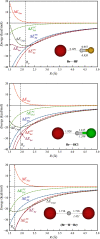The Importance of Electrostatics and Polarization for Noncovalent Interactions: Ionic Hydrogen Bonds vs Ionic Halogen Bonds
- PMID: 36006525
- PMCID: PMC9411100
- DOI: 10.1007/s00894-022-05189-6
The Importance of Electrostatics and Polarization for Noncovalent Interactions: Ionic Hydrogen Bonds vs Ionic Halogen Bonds
Abstract
A series of 26 hydrogen-bonded complexes between Br- and halogen, oxygen and sulfur hydrogen-bond (HB) donors is investigated at the M06-2X/6-311 + G(2df,2p) level of theory. Analysis using a model in which Br- is replaced by a point charge shows that the interaction energy ([Formula: see text]) of the complexes is accurately reproduced by the scaled interaction energy with the point charge ([Formula: see text]).This is demonstrated by [Formula: see text] with a correlation coefficient, R2 =0.999. The only outlier is (Br-H-Br)-, which generally is classified as a strong charge-transfer complex with covalent character rather than a HB complex. [Formula: see text] can be divided rigorously into an electrostatic contribution ([Formula: see text]) and a polarization contribution ([Formula: see text]).Within the set of HB complexes investigated, the former varies between -7.2 and -32.7 kcal mol-1, whereas the latter varies between -1.6 and -11.5 kcal mol-1. Compared to our previous study of halogen-bonded (XB) complexes between Br- and C-Br XB donors, the electrostatic contribution is generally stronger and the polarization contribution is generally weaker in the HB complexes. However, for both types of bonding, the variation in interaction strength can be reproduced accurately without invoking a charge-transfer term. For the Br-···HF complex, the importance of charge penetration on the variation of the interaction energy with intermolecular distance is investigated. It is shown that the repulsive character of [Formula: see text] at short distances in this complex to a large extent can be attributed to charge penetration.
Keywords: Charge penetration; Electrostatic potential; Halogen bond; Hydrogen bond; Intermolecular interaction.
© 2022. The Author(s).
Conflict of interest statement
The authors declare no competing interests.
Figures





References
-
- Brinck T, Murray J, Politzer P (1992) Surface electrostatic potentials of halogenated methanes as indicators of directional intermolecular interactions. Int J Quant Chem 57–64.
-
- Koch U, Popelier PLA. Characterization of C-H-O hydrogen bonds on the basis of the charge density. J Phys Chem. 1995;99:9747–9754. doi: 10.1021/j100024a016. - DOI
-
- B Jeziorski, K Szalewicz, Intermolecular Interactions by Perturbation Theory. in Encyclopedia of computational chemistry, 2, edited by P von Rague Schleyer, Allinger, NL, Clark, T., Gasteiger, J., Kollman, PA, Schaefer III, HF, Schreiner, PR (John Wiley and Sons, Chichester, U.K., 1998), 1376.
LinkOut - more resources
Full Text Sources
Research Materials
Miscellaneous

